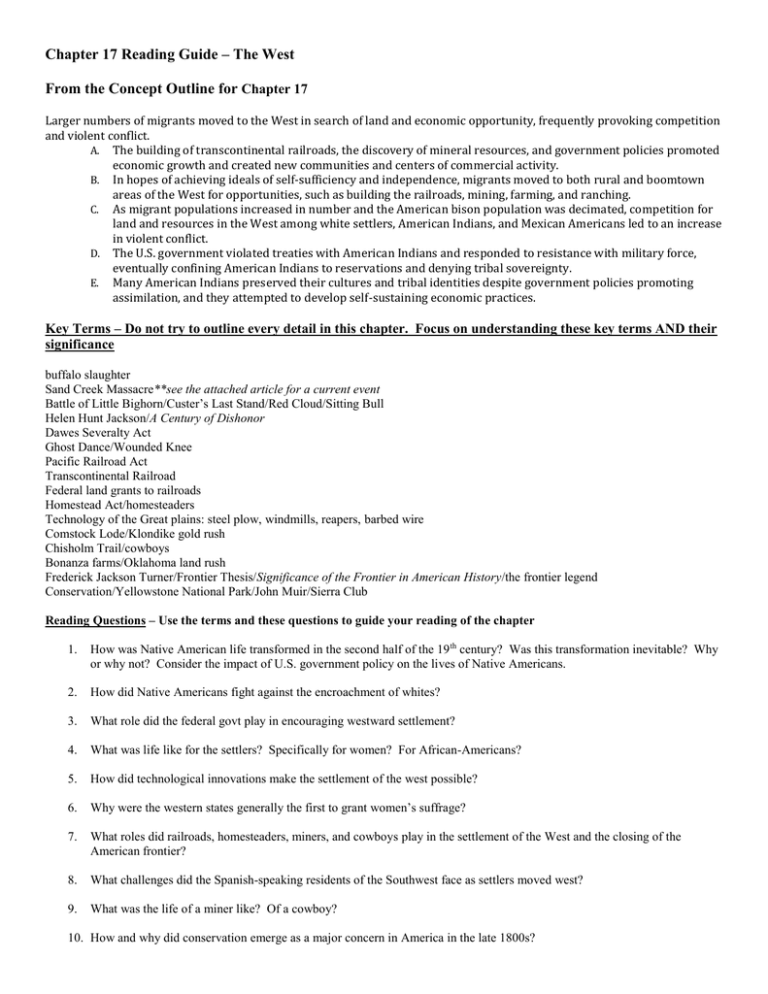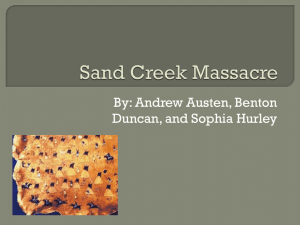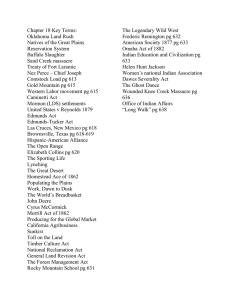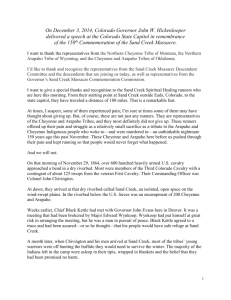Chapter 17 Reading Guide – The West Chapter 17
advertisement

Chapter 17 Reading Guide – The West From the Concept Outline for Chapter 17 Larger numbers of migrants moved to the West in search of land and economic opportunity, frequently provoking competition and violent conflict. A. The building of transcontinental railroads, the discovery of mineral resources, and government policies promoted economic growth and created new communities and centers of commercial activity. B. In hopes of achieving ideals of self-sufficiency and independence, migrants moved to both rural and boomtown areas of the West for opportunities, such as building the railroads, mining, farming, and ranching. C. As migrant populations increased in number and the American bison population was decimated, competition for land and resources in the West among white settlers, American Indians, and Mexican Americans led to an increase in violent conflict. D. The U.S. government violated treaties with American Indians and responded to resistance with military force, eventually confining American Indians to reservations and denying tribal sovereignty. E. Many American Indians preserved their cultures and tribal identities despite government policies promoting assimilation, and they attempted to develop self-sustaining economic practices. Key Terms – Do not try to outline every detail in this chapter. Focus on understanding these key terms AND their significance buffalo slaughter Sand Creek Massacre**see the attached article for a current event Battle of Little Bighorn/Custer’s Last Stand/Red Cloud/Sitting Bull Helen Hunt Jackson/A Century of Dishonor Dawes Severalty Act Ghost Dance/Wounded Knee Pacific Railroad Act Transcontinental Railroad Federal land grants to railroads Homestead Act/homesteaders Technology of the Great plains: steel plow, windmills, reapers, barbed wire Comstock Lode/Klondike gold rush Chisholm Trail/cowboys Bonanza farms/Oklahoma land rush Frederick Jackson Turner/Frontier Thesis/Significance of the Frontier in American History/the frontier legend Conservation/Yellowstone National Park/John Muir/Sierra Club Reading Questions – Use the terms and these questions to guide your reading of the chapter 1. How was Native American life transformed in the second half of the 19 th century? Was this transformation inevitable? Why or why not? Consider the impact of U.S. government policy on the lives of Native Americans. 2. How did Native Americans fight against the encroachment of whites? 3. What role did the federal govt play in encouraging westward settlement? 4. What was life like for the settlers? Specifically for women? For African-Americans? 5. How did technological innovations make the settlement of the west possible? 6. Why were the western states generally the first to grant women’s suffrage? 7. What roles did railroads, homesteaders, miners, and cowboys play in the settlement of the West and the closing of the American frontier? 8. What challenges did the Spanish-speaking residents of the Southwest face as settlers moved west? 9. What was the life of a miner like? Of a cowboy? 10. How and why did conservation emerge as a major concern in America in the late 1800s? 150 Years Later, A Formal Apology For The Sand Creek Massacre (This happened last year) DECEMBER 15, 2014 4:34 PM ET, NPR A stretch of dry, empty prairie where the Sand Creek Massacre took place in Colorado has hardly changed in a century and a half. Back in December 1864, America was still months from the end of the Civil War. Gen. William Sherman was making his infamous march across Georgia. And from the Western Frontier, word of the shocking Sand Creek Massacre was starting to trickle out. A regiment of volunteer troops in Colorado had attacked a peaceful camp of Native Americans, slaughtering nearly 200 of them — mostly women and children. The creek itself is just a curve of sand and a scattering of cottonwoods. But for Karen Little Coyote of the Cheyenne tribe, this is a sacred place. "Something comes over me each time I come out here. You can feel the spirits out here," Little Coyote says. In 1864, Cheyenne and Arapaho chiefs brought their people to Sand Creek to wait for peace negotiations with the territorial government. Instead, the village was attacked early one morning by United States cavalry, a volunteer regiment led by a colonel bent on driving Indians out of the territory. Little Coyote's great-great grandfather Chief Black Kettle survived the massacre. "You can stand there and you can just imagine what happened out here. Women, children, screaming and crying and don't know what's going on," Little Coyote says. Hundreds of Cheyenne and Arapaho returned to the massacre site recently to mark the 150th anniversary with private ceremonies and a public education program. Martin Braided Hair stretched white canvas over a frame of poles, one of several teepees the tribes put up for their rituals. Braided Hair says visiting the massacre site is an important way for the Cheyenne to connect with their history — from their near-annihilation at Sand Creek to their struggles to survive today. "We're having a hard time with our language, with our way of life. And each time we come back, it gets stronger and stronger," he said. Congress made this stretch of Sand Creek a National Historic Site less than a decade ago and gave it a heavy mission. Alexa Roberts, superintendent of the site, says the goal is not just to remember the massacre but to use that memory to try to prevent future atrocities. "This wasn't just an event in history; it wasn't something that just happened and is over," Roberts says. "The things that could bring about an atrocity of this magnitude — those were human things, and that potential is still in people." The horror of Sand Creek didn't end with the massacre. Soldiers took scalps and other grisly trophies from the dead and brought them back to Denver for public display. The outrage of those actions prompted the tribes to start an annual healing run, leaving the site after the anniversary and following the same route the soldiers took back to Denver. Wilma Blackbear and Janet Bull Coming traveled from Oklahoma to take part this year. "It's to heal ourselves ... pray, and give us strength to help move on," they said. On a chilly Denver morning, a traditional chant followed tribe members and supporters as they set off on the final leg of the run. Their route ended at the state capitol, where Colorado's governor, John Hickenlooper, was waiting to do something none of his predecessors have done before: formally apologize for the Sand Creek Massacre.




